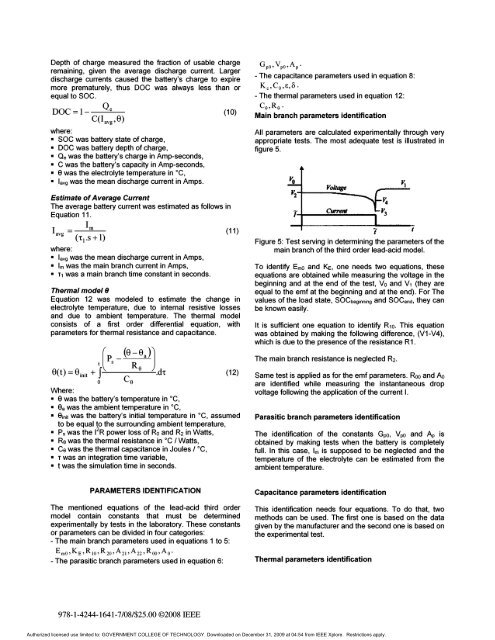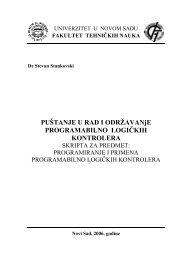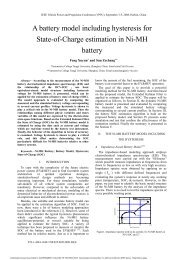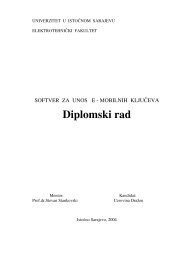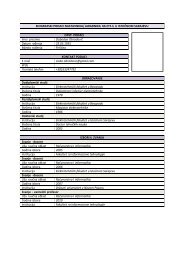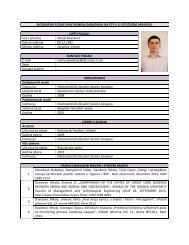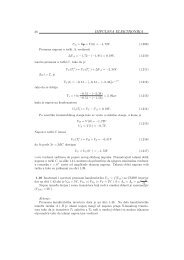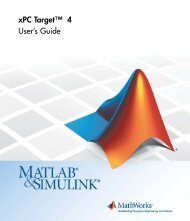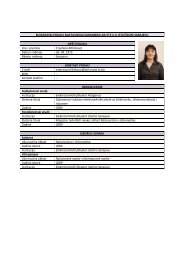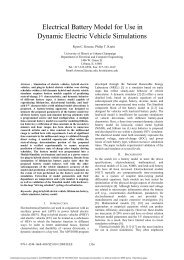parameter identification of the lead-acid battery model
parameter identification of the lead-acid battery model
parameter identification of the lead-acid battery model
You also want an ePaper? Increase the reach of your titles
YUMPU automatically turns print PDFs into web optimized ePapers that Google loves.
Depth <strong>of</strong> charge measured <strong>the</strong> fraction <strong>of</strong> usable chargeremaining, given <strong>the</strong> average discharge current. Largerdischarge currents caused <strong>the</strong> <strong>battery</strong>'s charge to expiremore prematurely, thus DOC was always less than orequal to SOC.where:• SOC was <strong>battery</strong> state <strong>of</strong> charge,• DOC was <strong>battery</strong> depth <strong>of</strong> charge,• Qe was <strong>the</strong> <strong>battery</strong>'s charge in Amp-seconds,• C was <strong>the</strong> <strong>battery</strong>'s capacity in Amp-seconds,• a was <strong>the</strong> electrolyte temperature in °c,• lavg was <strong>the</strong> mean discharge current in Amps.Estimate <strong>of</strong> Average CurrentThe average <strong>battery</strong> current was estimated as follows inEquation 11.(10)lavg = 1m (11)(t l ·s+l)where:• lavg was <strong>the</strong> mean discharge current in Amps,• 1m was <strong>the</strong> main branch current in Amps,• T1 was a main branch time constant in seconds.Thermal <strong>model</strong>SEquation 12 was <strong>model</strong>ed to estimate <strong>the</strong> change inelectrolyte temperature, due to intemal resistive lossesand due to ambient temperature. The <strong>the</strong>rmal <strong>model</strong>consists <strong>of</strong> a first order differential equation, with<strong>parameter</strong>s for <strong>the</strong>rmal resistance and capacitance.Gpo, Vpo,Ap.- The capacitance <strong>parameter</strong>s used in equation 8:Kc,Co,E,O.- The <strong>the</strong>rmal <strong>parameter</strong>s used in equation 12:Ca,Ra ·Main branch <strong>parameter</strong>s <strong>identification</strong>All <strong>parameter</strong>s are calculated experimentally through veryappropriate tests. The most adequate test is illustrated infigure 5."'0 J)J'oltopJ114Cummtr "'31Figure 5: Test serving in determining <strong>the</strong> <strong>parameter</strong>s <strong>of</strong> <strong>the</strong>main branch <strong>of</strong> <strong>the</strong> third order <strong>lead</strong>-<strong>acid</strong> <strong>model</strong>.To identify Emo and KE, one needs two equations, <strong>the</strong>seequations are obtained while measuring <strong>the</strong> voltage in <strong>the</strong>beginning and at <strong>the</strong> end <strong>of</strong> <strong>the</strong> test, Vo and V1 (<strong>the</strong>y areequal to <strong>the</strong> emf at <strong>the</strong> beginning and at <strong>the</strong> end). For Thevalues <strong>of</strong> <strong>the</strong> load state, SOCbeginning and SOCend, <strong>the</strong>y canbe known easily.It is sufficient one equation to identify R10. This equationwas obtained by making <strong>the</strong> following difference, (V1-V4),which is due to <strong>the</strong> presence <strong>of</strong> <strong>the</strong> resistance R1.The main branch resistance is neglected R2.Where:• a was <strong>the</strong> <strong>battery</strong>'s temperature in °c,• aa was <strong>the</strong> ambient temperature in °c,• aini! was <strong>the</strong> <strong>battery</strong>'s initial temperatureto be equal to <strong>the</strong> surrounding ambient temperature,• P s was <strong>the</strong> 12R power loss <strong>of</strong> Ro and R2 in Watts,• Re was <strong>the</strong> <strong>the</strong>rmal resistance in °c 1 Watts,• Ce was <strong>the</strong> <strong>the</strong>rmal capacitance in Joules 1°C,• T was an integration time variable,• t was <strong>the</strong> simulation time in seconds.(12)in °c, assumedSame test is applied as for <strong>the</strong> emf <strong>parameter</strong>s. Roo and Aoare identified while measuring <strong>the</strong> instantaneous dropvoltage following <strong>the</strong> application <strong>of</strong> <strong>the</strong> current I.Parasitic branch <strong>parameter</strong>s <strong>identification</strong>The <strong>identification</strong> <strong>of</strong> <strong>the</strong> constants GpO, Vpo and Ap isobtained by making tests when <strong>the</strong> <strong>battery</strong> is completelyfull. In this case, 1m is supposed to be neglected and <strong>the</strong>temperature <strong>of</strong> <strong>the</strong> electrolyte can be estimated from <strong>the</strong>ambient temperature.PARAMETERS IDENTIFICATIONThe mentioned equations <strong>of</strong> <strong>the</strong> <strong>lead</strong>-<strong>acid</strong> third order<strong>model</strong> contain constants that must be determinedexperimentally by tests in <strong>the</strong> laboratory. These constantsor <strong>parameter</strong>s can be divided in four categories:- The main branch <strong>parameter</strong>s used in equations 1 to 5:EmO,KE ,RIO,R20,A21' A22 ,Roo,Ao·- The parasitic branch <strong>parameter</strong>s used in equation 6:Capacitance <strong>parameter</strong>s <strong>identification</strong>This <strong>identification</strong> needs four equations. To do that, twomethods can be used. The first one is based on <strong>the</strong> datagiven by <strong>the</strong> manufacturer and <strong>the</strong> second one is based on<strong>the</strong> experimental test.Thermal <strong>parameter</strong>s <strong>identification</strong>978-1-4244-1641-7/08/$25.00 ©2008 IEEEAuthorized licensed use limited to: GOVERNMENT COLLEGE OF TECHNOLOGY. Downloaded on December 31, 2009 at 04:54 from IEEE Xplore. Restrictions apply.


